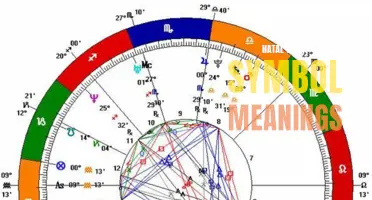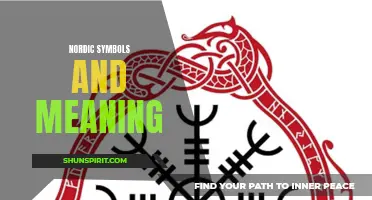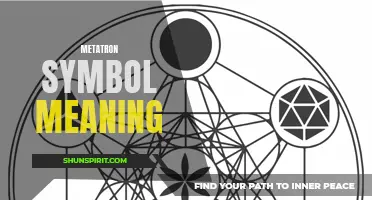
Cascarones, the vibrant and colorful decorative eggs popularly used during festive celebrations in many Latin American countries, hold a deeper symbolic meaning beyond their outward beauty. These delicate shells, typically filled with confetti or sometimes even small messages, represent joy, good fortune, and the power of transformation. From their creation to their cracking, cascarones embody a tradition that reminds us of the fleeting nature of happiness and the potential for new beginnings hidden within even the most ordinary of objects.
What You'll Learn
- What is the origin of cascarones and their symbolism?
- How are cascarones used in different cultural celebrations or traditions?
- How do the colors of cascarones contribute to their symbolic meaning?
- Are there any specific events or occasions where cascarones are particularly significant?
- In what ways do cascarones symbolize good luck or happiness?

What is the origin of cascarones and their symbolism?
Cascarones are a popular Mexican tradition dating back hundreds of years. These colorful eggs are a staple of celebrations and are often seen during Easter and other festive occasions. But what exactly is the origin of cascarones and what is their symbolism? Let's take a closer look.
The word "cascarones" is derived from the Spanish word "cáscara," which means "shell" or "peel." The tradition of cascarones can be traced back to early Mesopotamia and Ancient Rome, where people would fill eggshells with perfumed water and throw them during festivals as a symbol of new life and rebirth.
It is believed that cascarones were introduced to Mexico by the Spanish conquistadors during the colonization period. The tradition quickly assimilated into Mexican culture and became deeply rooted in the country's customs and celebrations.
Cascarones are typically made by carefully hollowing out chicken eggs and filling them with confetti or small pieces of colored paper. The eggs are then sealed with colorful tissue paper and decorated with intricate designs, glitter, and sometimes feathers. The result is a beautifully crafted, ornamental egg that can be cracked open during festivities.
The symbolism of cascarones is tied to both their Easter origins and the celebration of life in general. In Christianity, Easter is a time to celebrate the resurrection of Jesus Christ and the promise of new life. Cascarones, with their vibrant colors and confetti-filled interiors, represent the joy and abundance that come with this religious holiday.
For many Mexicans, cascarones are also seen as a symbol of good luck and prosperity. The act of cracking an egg over someone's head is believed to bring good fortune and blessings upon them. It is not uncommon to see people playfully smashing cascarones on each other's heads during festive gatherings, spreading joy and laughter.
Aside from their symbolic meaning, cascarones also serve as a form of entertainment and a way to bring people together. Breaking cascarones over someone's head is a playful and lighthearted tradition that creates a sense of camaraderie and unity among family and friends.
In recent years, cascarones have gained popularity beyond Mexico and are now enjoyed in various parts of the world, particularly in areas with large Mexican communities. They have become a symbol of Mexican culture and are often used in festivals, parades, and other celebrations as a way to honor the country's traditions.
In conclusion, cascarones are an important and beloved tradition in Mexican culture. With their origins rooted in ancient rituals of rebirth and new life, these ornamental eggs have come to symbolize joy, prosperity, and unity. Whether cracked over someone's head for good luck or simply used as a decorative element, cascarones continue to be a cherished part of Mexican celebrations and a beautiful representation of the country's rich cultural heritage.
Understanding the Meaning of Mini Cooper Fuse Box Symbols
You may want to see also

How are cascarones used in different cultural celebrations or traditions?
Cascarones are colorful eggshells filled with confetti or small toys that are used in various cultural celebrations and traditions around the world. These festive objects are a popular form of celebration and are often associated with Easter, but they are also used in other events and festivals. Here are some examples of how cascarones are used in different cultural celebrations or traditions:
- Easter in Mexico: In Mexico, cascarones are an integral part of the Easter celebrations. During this time, families gather to decorate the cascarones with vibrant colored tissue paper. These decorated eggs are then used in a game where children crack the cascarones over each other's heads, showering them with confetti. It is believed that the confetti represents good luck and blessings for the recipient.
- Fiesta de San Antonio: The Fiesta de San Antonio is an annual festival celebrated in San Antonio, Texas. Cascarones are an important element of this festival, where participants enjoy cracking colorful eggs on each other's heads. The festival attracts thousands of visitors who participate in parades, music concerts, and other cultural events. The use of cascarones adds a fun and lively element to the festival.
- Carnaval in Brazil: The cascarones, known as ovos de Páscoa, are used during the Carnaval celebrations in Brazil. Similar to the Mexican tradition, cascarones are filled with confetti or small toys. The eggs are not only cracked over people's heads but are also used as a playful weapon during water fights and street parades. The cascarones represent joy and celebration during this vibrant and colorful festival.
- Quinceañera: The Quinceañera is a traditional celebration of a girl's 15th birthday in Mexican, Mexican-American, and other Latin American cultures. Cascarones are often included as part of the festivities. During the celebration, the birthday girl dances a waltz with her father, and at the end of the dance, the guests shower her with cascarones, symbolizing good luck and happiness for her transition into adulthood.
- Day of the Dead in Mexico: While cascarones are primarily associated with Easter, they are also used in the Day of the Dead celebrations in Mexico. During this holiday, families create altars to honor their deceased loved ones. Cascarones are sometimes placed on these altars as a symbol of joy and celebration, reminding the living to cherish their time on Earth.
In conclusion, cascarones are used in various cultural celebrations and traditions around the world. Whether it's Easter, Carnaval, Quinceañera, or the Day of the Dead, cascarones bring joy, color, and a sense of celebration to these special occasions. The cracking of the cascarones and the shower of confetti symbolize good luck, happiness, and the joy of life.
Unveiling the Magical World of Wizard Symbols: Their Fascinating Meanings and Power
You may want to see also

How do the colors of cascarones contribute to their symbolic meaning?
Cascarones are an important part of many cultural celebrations, especially in Mexican culture. These colorful eggs are usually filled with confetti and often used during Easter or other festive occasions. The colors used in cascarones hold significant meaning and contribute to the symbolism of these special eggs.
In Mexican culture, each color has its own symbolic meaning. Red, for example, is associated with love and passion. It represents strong emotions and serves as a reminder of the importance of love and affection in our lives. Orange is a color that symbolizes joy and enthusiasm. It brings a sense of energy and excitement, reminding us to embrace life's vibrant moments.
Yellow is often associated with happiness and friendship. It represents the warmth and optimism that comes from having strong bonds with others. Green, on the other hand, is a color that symbolizes growth and renewal. It is often used to represent nature and the cycle of life. Green reminds us of the importance of nurturing and taking care of ourselves and the world around us.
Blue is a color that is often associated with peace and tranquility. It represents calmness and serenity, serving as a reminder to find stillness in our busy lives. Purple, on the other hand, is a color that is often associated with spirituality and creativity. It represents wisdom and imagination, reminding us to tap into our inner selves and embrace our unique gifts.
Lastly, pink is a color often associated with love and compassion. It represents kindness and empathy towards others. Pink cascarones serve as a reminder to be gentle with others and to approach life with a sense of understanding and care.
The symbolism of cascarones goes beyond just their colors. They are often seen as a representation of rebirth and new beginnings. Breaking a cascaron over someone's head is believed to bring good luck and blessings. This act symbolizes the breaking of old patterns and the ushering in of positive change.
In conclusion, the colors of cascarones contribute significantly to their symbolic meaning. Each color holds its own significance in Mexican culture and is associated with specific emotions or traits. Through their vibrant colors, cascarones serve as a visual representation of these qualities and remind us of their importance in our lives.
The Intriguing Meanings Behind Chinese Symbols
You may want to see also

Are there any specific events or occasions where cascarones are particularly significant?
Cascarones, also known as confetti eggs, are a traditional Mexican item that is widely used in celebrations and events. These colorful eggs are filled with confetti and are cracked over someone's head to symbolize good luck and happiness. While cascarones can be used in various events, there are a few specific occasions where they hold particular significance.
- Easter: The most prominent event associated with cascarones is Easter. In Mexico, cascarones are an essential part of the Easter celebrations. It is a common tradition to have cascarones at Easter gatherings, where people participate in cascarones fights, cracking the eggs over each other's heads. This festive activity adds an element of fun and excitement to the Easter festivities.
- Carnivals and Parades: Cascarones are often seen in carnivals and parades, especially in Mexico and some parts of the United States with a significant Hispanic population. The colorful eggs are thrown, cracked, and smashed during these events, creating a lively and joyful atmosphere. Cascarones add a touch of playfulness and cheerfulness to the festive spirit of carnivals and parades.
- Weddings and Celebrations: Cascarones are also used in weddings and other celebratory occasions to signify joy, happiness, and good fortune. Couples may choose to incorporate cascarones into their wedding reception, allowing guests to crack the eggs over each other's heads as a symbol of well wishes and blessings for the newlyweds. These vibrant eggs add a festive touch to the celebration and create a memorable experience for everyone involved.
- Birthdays and Parties: Cascarones are a popular addition to birthday parties and other private celebrations. They can be used as party favors, with guests cracking the eggs over each other's heads for a fun and exciting surprise. The confetti inside the eggs adds a colorful and festive element to the celebration, making it even more memorable and enjoyable for everyone.
It is worth mentioning that cascarones are not limited to these specific events and occasions. They can be used in any gathering or celebration where adding an element of joy, playfulness, and good luck is desired. Whether it's a family get-together, a community festival, or a corporate event, cascarones have the power to bring smiles and laughter to people of all ages.
In conclusion, cascarones are particularly significant in Easter celebrations, carnivals, parades, weddings, birthdays, and other festive occasions. These colorful eggs symbolize good luck, happiness, and well wishes. Incorporating cascarones into these events adds an element of fun and excitement, creating memorable experiences for all participants. So, the next time you have a reason to celebrate, consider including cascarones to make the event even more special.
Exploring the Meaning Behind the Battery with Recycle Symbol
You may want to see also

In what ways do cascarones symbolize good luck or happiness?
Cascarones are beautifully decorated, hollowed-out eggshells that are filled with confetti or small trinkets and then sealed. They are commonly used in celebrations and festivals in many Latin American countries, particularly during Easter. Cascarones are often seen as a symbol of good luck and happiness, and they play an important role in the cultural heritage of these countries.
One way in which cascarones symbolize good luck is through the act of breaking them. It is believed that by breaking a cascaron over someone's head, you are releasing its positive energy and blessings onto them. This act is seen as a way to bring good fortune and happiness to the person being showered with the confetti and blessings. Breaking cascarones is often a playful and joyous activity, creating a sense of happiness and laughter.
Another way in which cascarones symbolize good luck is through their vibrant and colorful designs. The eggs are often intricately decorated with bright colors and intricate designs, making them visually appealing. The use of vibrant colors is believed to attract positive energy and bring good luck to the person who receives or breaks the cascaron. The beautiful designs also add to the festive atmosphere of celebrations, creating a sense of happiness and joy.
Cascarones are also associated with the Easter holiday, which is a time of renewal and new beginnings. The hollowed-out eggshells represent the empty tomb of Jesus, symbolizing the triumph of life over death. This association with Easter adds a spiritual significance to cascarones, and they are often used in religious ceremonies and processions. The use of cascarones during Easter further reinforces their symbolism of good luck and happiness, as it is believed that the blessings received from breaking cascarones during this time will carry over into the rest of the year.
In addition to their symbolism of good luck and happiness, cascarones also have a social aspect. The act of breaking cascarones is often done in a social setting, such as at a party or gathering. This brings people together and creates a sense of community and camaraderie. Breaking cascarones with friends and family is a shared experience that fosters joy and happiness, strengthening relationships and creating memories.
In conclusion, cascarones symbolize good luck and happiness in several ways. The act of breaking them is believed to release positive energy and blessings onto the person being showered with confetti. The beautiful and vibrant designs of cascarones attract positive energy and add to the festive atmosphere of celebrations. The association with Easter adds a spiritual significance to cascarones and further reinforces their symbolism of good luck and happiness. Moreover, the social aspect of breaking cascarones fosters a sense of community and brings people together in joy and happiness. Overall, cascarones are a cherished symbol of good luck and happiness in many Latin American cultures.
Understanding the Nissan Sentra Dashboard Symbols and Meanings
You may want to see also
Frequently asked questions
Cascarones have a symbolic meaning in Mexican culture. These brightly colored eggshells filled with confetti or small toys are traditionally used during celebrations such as Easter and other festive occasions. They symbolize good luck and are believed to bring joy, happiness, and blessings to the person they are cracked over.
The tradition of cascarones originated in Europe and was brought to Mexico by Spanish settlers during the colonial period. Over time, it became a popular tradition in Mexican culture, especially during Easter celebrations, where the cascarones are used in various festivities, such as egg fights and the breaking of cascarones over people's heads.
Cascarones are used in celebrations by cracking them over the heads of friends and family members. The act of cracking a cascaron represents the sharing of good luck and blessings with the person being cracked over. The confetti or small toys that are inside the cascarones symbolize the joy and happiness that is being wished upon the person. It is a fun and playful tradition that adds an element of surprise and excitement to any celebration.







